EHR Implementation: Identifying Key Stakeholders - HCI112 Report
VerifiedAdded on 2023/04/17
|11
|2258
|95
Report
AI Summary
This report examines the various stakeholders involved in the implementation of Electronic Health Record (EHR) projects within the healthcare sector. It identifies key stakeholders such as hospital management, health practitioners, clients/patients, office staff, EHR project team members, accounting officers, EHR developers/vendors, and the community. The report details the specific roles each stakeholder plays, from financing and evaluation by hospital management to providing technical knowledge and system testing by health practitioners and accounting officers. Patients contribute by providing accurate health information, while office staff offers insights based on their experience with record storage. The EHR project team manages finances, selects the appropriate system, and trains users. EHR vendors provide technical support and system updates, and the community offers feedback on usability. The report concludes that successful EHR implementation relies on the engagement and coordinated efforts of all stakeholders, ensuring a comprehensive approach to improving healthcare delivery.
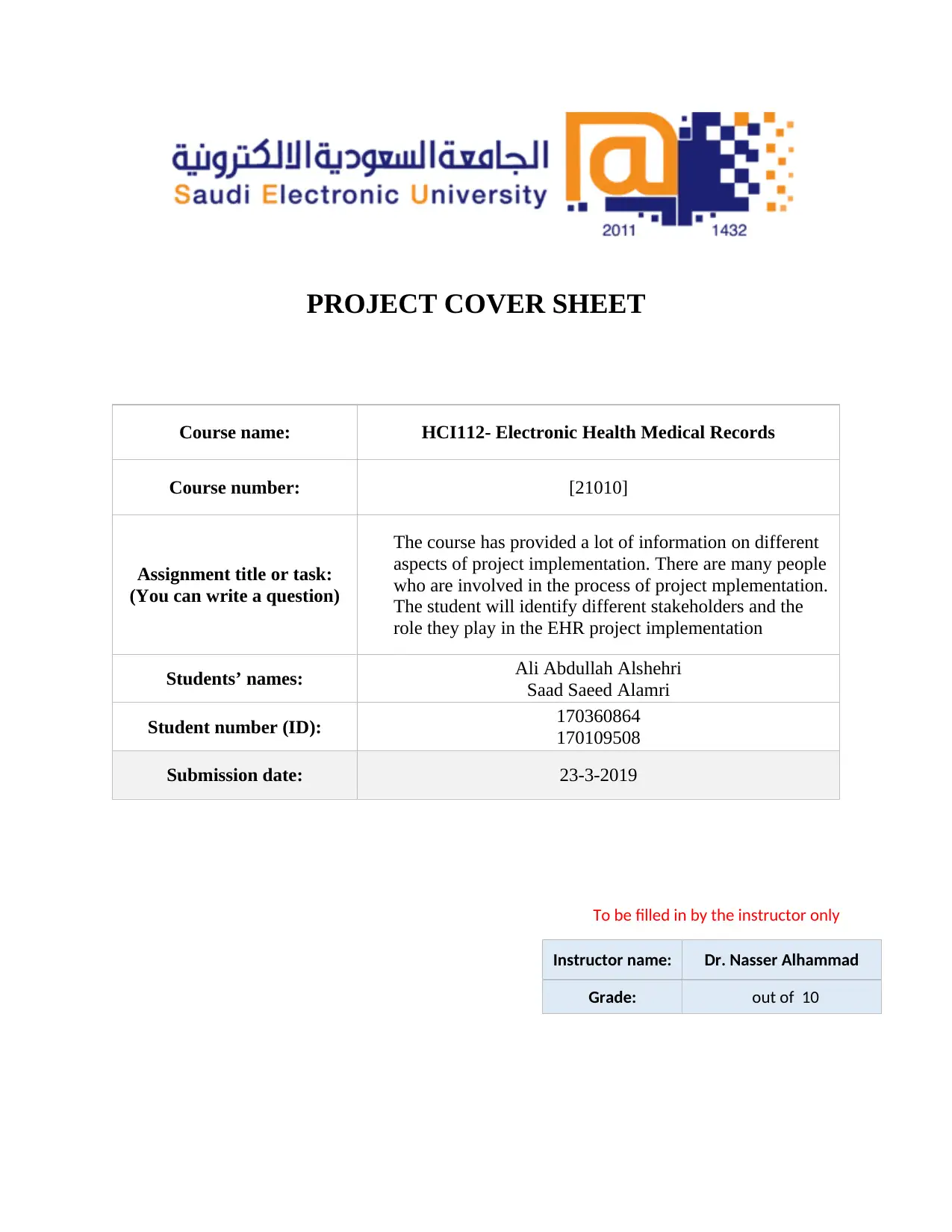
PROJECT COVER SHEET
Course name: HCI112- Electronic Health Medical Records
Course number: [21010]
Assignment title or task:
(You can write a question)
The course has provided a lot of information on different
aspects of project implementation. There are many people
who are involved in the process of project mplementation.
The student will identify different stakeholders and the
role they play in the EHR project implementation
Students’ names: Ali Abdullah Alshehri
Saad Saeed Alamri
Student number (ID): 170360864
170109508
Submission date: 23-3-2019
To be filled in by the instructor only
Instructor name: Dr. Nasser Alhammad
Grade: out of 10
Course name: HCI112- Electronic Health Medical Records
Course number: [21010]
Assignment title or task:
(You can write a question)
The course has provided a lot of information on different
aspects of project implementation. There are many people
who are involved in the process of project mplementation.
The student will identify different stakeholders and the
role they play in the EHR project implementation
Students’ names: Ali Abdullah Alshehri
Saad Saeed Alamri
Student number (ID): 170360864
170109508
Submission date: 23-3-2019
To be filled in by the instructor only
Instructor name: Dr. Nasser Alhammad
Grade: out of 10
Paraphrase This Document
Need a fresh take? Get an instant paraphrase of this document with our AI Paraphraser
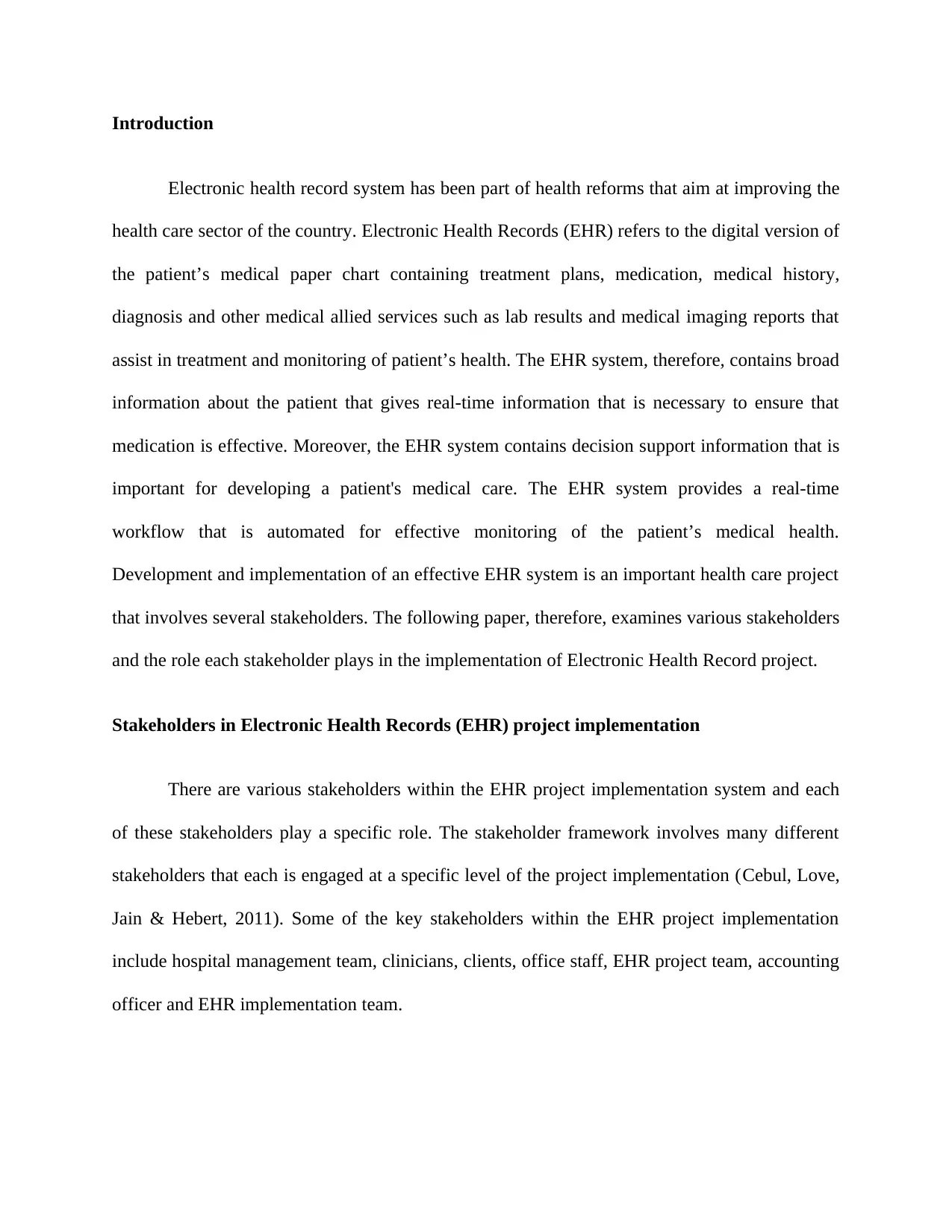
Introduction
Electronic health record system has been part of health reforms that aim at improving the
health care sector of the country. Electronic Health Records (EHR) refers to the digital version of
the patient’s medical paper chart containing treatment plans, medication, medical history,
diagnosis and other medical allied services such as lab results and medical imaging reports that
assist in treatment and monitoring of patient’s health. The EHR system, therefore, contains broad
information about the patient that gives real-time information that is necessary to ensure that
medication is effective. Moreover, the EHR system contains decision support information that is
important for developing a patient's medical care. The EHR system provides a real-time
workflow that is automated for effective monitoring of the patient’s medical health.
Development and implementation of an effective EHR system is an important health care project
that involves several stakeholders. The following paper, therefore, examines various stakeholders
and the role each stakeholder plays in the implementation of Electronic Health Record project.
Stakeholders in Electronic Health Records (EHR) project implementation
There are various stakeholders within the EHR project implementation system and each
of these stakeholders play a specific role. The stakeholder framework involves many different
stakeholders that each is engaged at a specific level of the project implementation (Cebul, Love,
Jain & Hebert, 2011). Some of the key stakeholders within the EHR project implementation
include hospital management team, clinicians, clients, office staff, EHR project team, accounting
officer and EHR implementation team.
Electronic health record system has been part of health reforms that aim at improving the
health care sector of the country. Electronic Health Records (EHR) refers to the digital version of
the patient’s medical paper chart containing treatment plans, medication, medical history,
diagnosis and other medical allied services such as lab results and medical imaging reports that
assist in treatment and monitoring of patient’s health. The EHR system, therefore, contains broad
information about the patient that gives real-time information that is necessary to ensure that
medication is effective. Moreover, the EHR system contains decision support information that is
important for developing a patient's medical care. The EHR system provides a real-time
workflow that is automated for effective monitoring of the patient’s medical health.
Development and implementation of an effective EHR system is an important health care project
that involves several stakeholders. The following paper, therefore, examines various stakeholders
and the role each stakeholder plays in the implementation of Electronic Health Record project.
Stakeholders in Electronic Health Records (EHR) project implementation
There are various stakeholders within the EHR project implementation system and each
of these stakeholders play a specific role. The stakeholder framework involves many different
stakeholders that each is engaged at a specific level of the project implementation (Cebul, Love,
Jain & Hebert, 2011). Some of the key stakeholders within the EHR project implementation
include hospital management team, clinicians, clients, office staff, EHR project team, accounting
officer and EHR implementation team.
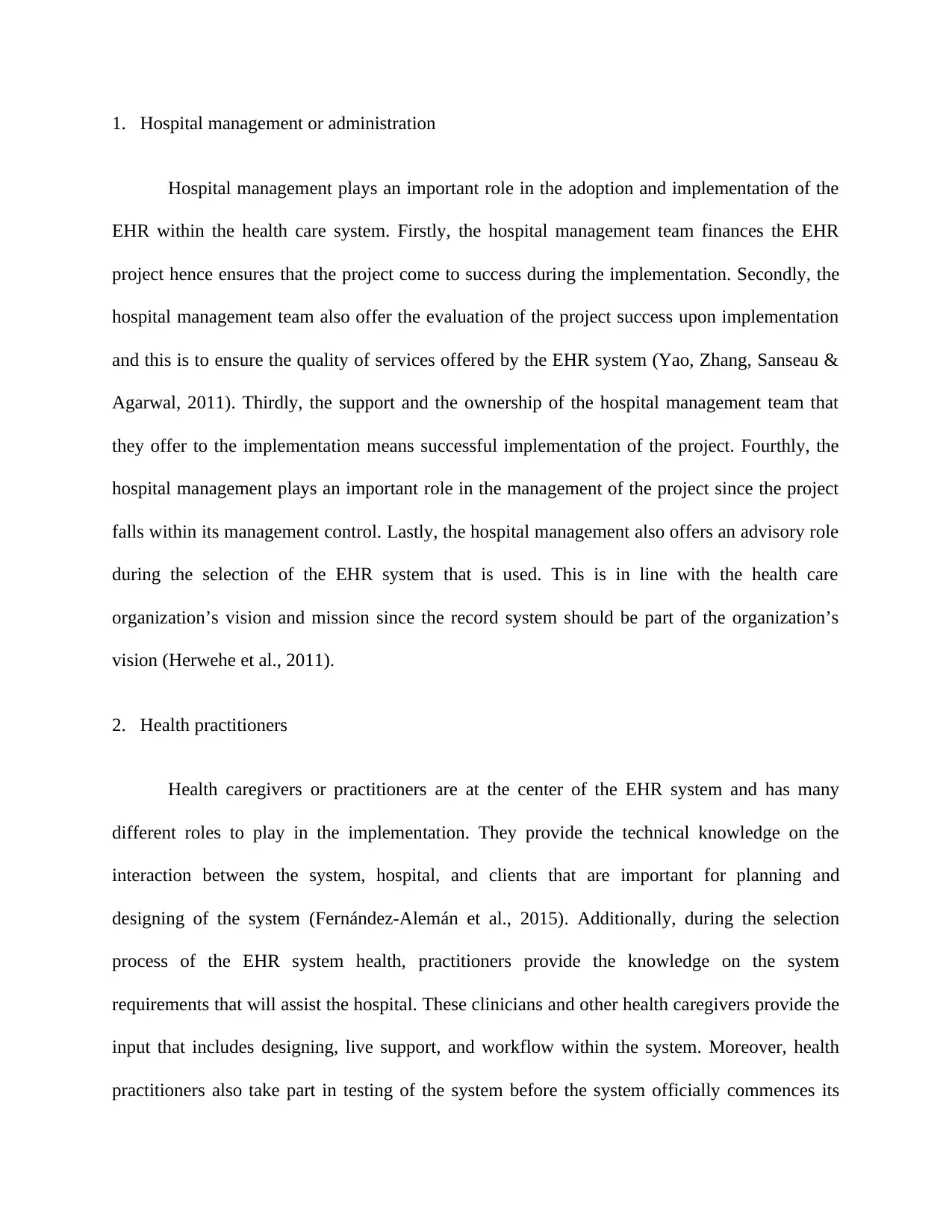
1. Hospital management or administration
Hospital management plays an important role in the adoption and implementation of the
EHR within the health care system. Firstly, the hospital management team finances the EHR
project hence ensures that the project come to success during the implementation. Secondly, the
hospital management team also offer the evaluation of the project success upon implementation
and this is to ensure the quality of services offered by the EHR system (Yao, Zhang, Sanseau &
Agarwal, 2011). Thirdly, the support and the ownership of the hospital management team that
they offer to the implementation means successful implementation of the project. Fourthly, the
hospital management plays an important role in the management of the project since the project
falls within its management control. Lastly, the hospital management also offers an advisory role
during the selection of the EHR system that is used. This is in line with the health care
organization’s vision and mission since the record system should be part of the organization’s
vision (Herwehe et al., 2011).
2. Health practitioners
Health caregivers or practitioners are at the center of the EHR system and has many
different roles to play in the implementation. They provide the technical knowledge on the
interaction between the system, hospital, and clients that are important for planning and
designing of the system (Fernández-Alemán et al., 2015). Additionally, during the selection
process of the EHR system health, practitioners provide the knowledge on the system
requirements that will assist the hospital. These clinicians and other health caregivers provide the
input that includes designing, live support, and workflow within the system. Moreover, health
practitioners also take part in testing of the system before the system officially commences its
Hospital management plays an important role in the adoption and implementation of the
EHR within the health care system. Firstly, the hospital management team finances the EHR
project hence ensures that the project come to success during the implementation. Secondly, the
hospital management team also offer the evaluation of the project success upon implementation
and this is to ensure the quality of services offered by the EHR system (Yao, Zhang, Sanseau &
Agarwal, 2011). Thirdly, the support and the ownership of the hospital management team that
they offer to the implementation means successful implementation of the project. Fourthly, the
hospital management plays an important role in the management of the project since the project
falls within its management control. Lastly, the hospital management also offers an advisory role
during the selection of the EHR system that is used. This is in line with the health care
organization’s vision and mission since the record system should be part of the organization’s
vision (Herwehe et al., 2011).
2. Health practitioners
Health caregivers or practitioners are at the center of the EHR system and has many
different roles to play in the implementation. They provide the technical knowledge on the
interaction between the system, hospital, and clients that are important for planning and
designing of the system (Fernández-Alemán et al., 2015). Additionally, during the selection
process of the EHR system health, practitioners provide the knowledge on the system
requirements that will assist the hospital. These clinicians and other health caregivers provide the
input that includes designing, live support, and workflow within the system. Moreover, health
practitioners also take part in testing of the system before the system officially commences its
⊘ This is a preview!⊘
Do you want full access?
Subscribe today to unlock all pages.

Trusted by 1+ million students worldwide
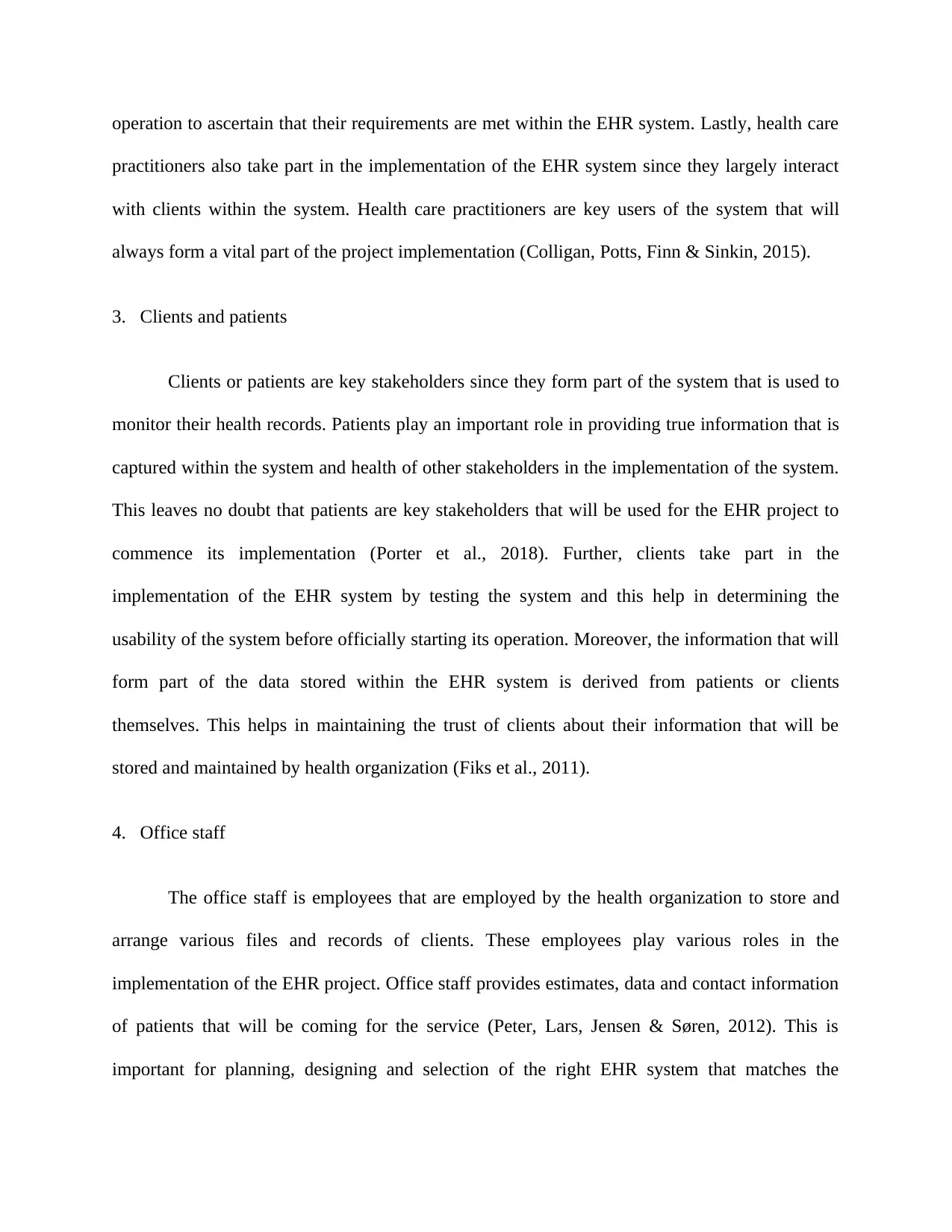
operation to ascertain that their requirements are met within the EHR system. Lastly, health care
practitioners also take part in the implementation of the EHR system since they largely interact
with clients within the system. Health care practitioners are key users of the system that will
always form a vital part of the project implementation (Colligan, Potts, Finn & Sinkin, 2015).
3. Clients and patients
Clients or patients are key stakeholders since they form part of the system that is used to
monitor their health records. Patients play an important role in providing true information that is
captured within the system and health of other stakeholders in the implementation of the system.
This leaves no doubt that patients are key stakeholders that will be used for the EHR project to
commence its implementation (Porter et al., 2018). Further, clients take part in the
implementation of the EHR system by testing the system and this help in determining the
usability of the system before officially starting its operation. Moreover, the information that will
form part of the data stored within the EHR system is derived from patients or clients
themselves. This helps in maintaining the trust of clients about their information that will be
stored and maintained by health organization (Fiks et al., 2011).
4. Office staff
The office staff is employees that are employed by the health organization to store and
arrange various files and records of clients. These employees play various roles in the
implementation of the EHR project. Office staff provides estimates, data and contact information
of patients that will be coming for the service (Peter, Lars, Jensen & Søren, 2012). This is
important for planning, designing and selection of the right EHR system that matches the
practitioners also take part in the implementation of the EHR system since they largely interact
with clients within the system. Health care practitioners are key users of the system that will
always form a vital part of the project implementation (Colligan, Potts, Finn & Sinkin, 2015).
3. Clients and patients
Clients or patients are key stakeholders since they form part of the system that is used to
monitor their health records. Patients play an important role in providing true information that is
captured within the system and health of other stakeholders in the implementation of the system.
This leaves no doubt that patients are key stakeholders that will be used for the EHR project to
commence its implementation (Porter et al., 2018). Further, clients take part in the
implementation of the EHR system by testing the system and this help in determining the
usability of the system before officially starting its operation. Moreover, the information that will
form part of the data stored within the EHR system is derived from patients or clients
themselves. This helps in maintaining the trust of clients about their information that will be
stored and maintained by health organization (Fiks et al., 2011).
4. Office staff
The office staff is employees that are employed by the health organization to store and
arrange various files and records of clients. These employees play various roles in the
implementation of the EHR project. Office staff provides estimates, data and contact information
of patients that will be coming for the service (Peter, Lars, Jensen & Søren, 2012). This is
important for planning, designing and selection of the right EHR system that matches the
Paraphrase This Document
Need a fresh take? Get an instant paraphrase of this document with our AI Paraphraser
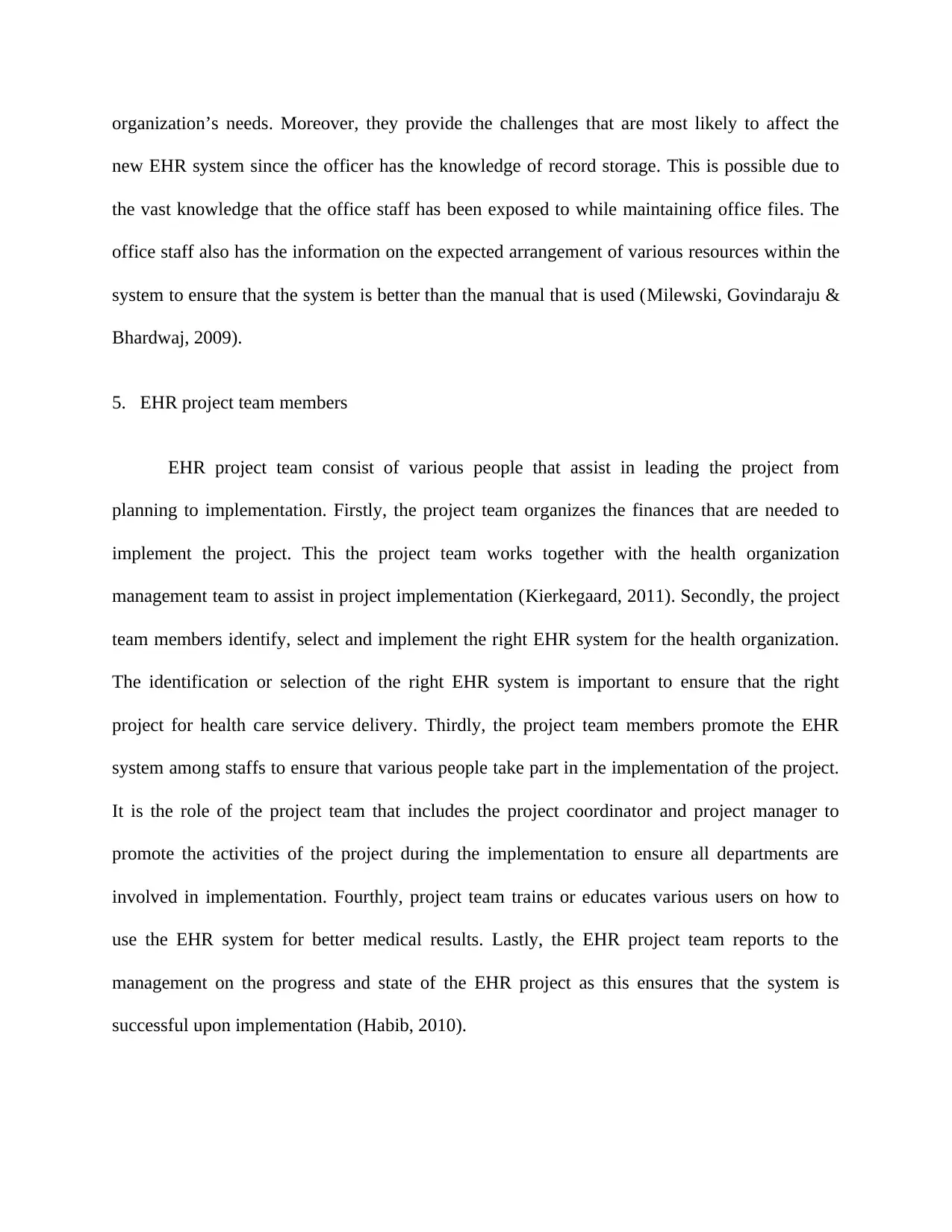
organization’s needs. Moreover, they provide the challenges that are most likely to affect the
new EHR system since the officer has the knowledge of record storage. This is possible due to
the vast knowledge that the office staff has been exposed to while maintaining office files. The
office staff also has the information on the expected arrangement of various resources within the
system to ensure that the system is better than the manual that is used (Milewski, Govindaraju &
Bhardwaj, 2009).
5. EHR project team members
EHR project team consist of various people that assist in leading the project from
planning to implementation. Firstly, the project team organizes the finances that are needed to
implement the project. This the project team works together with the health organization
management team to assist in project implementation (Kierkegaard, 2011). Secondly, the project
team members identify, select and implement the right EHR system for the health organization.
The identification or selection of the right EHR system is important to ensure that the right
project for health care service delivery. Thirdly, the project team members promote the EHR
system among staffs to ensure that various people take part in the implementation of the project.
It is the role of the project team that includes the project coordinator and project manager to
promote the activities of the project during the implementation to ensure all departments are
involved in implementation. Fourthly, project team trains or educates various users on how to
use the EHR system for better medical results. Lastly, the EHR project team reports to the
management on the progress and state of the EHR project as this ensures that the system is
successful upon implementation (Habib, 2010).
new EHR system since the officer has the knowledge of record storage. This is possible due to
the vast knowledge that the office staff has been exposed to while maintaining office files. The
office staff also has the information on the expected arrangement of various resources within the
system to ensure that the system is better than the manual that is used (Milewski, Govindaraju &
Bhardwaj, 2009).
5. EHR project team members
EHR project team consist of various people that assist in leading the project from
planning to implementation. Firstly, the project team organizes the finances that are needed to
implement the project. This the project team works together with the health organization
management team to assist in project implementation (Kierkegaard, 2011). Secondly, the project
team members identify, select and implement the right EHR system for the health organization.
The identification or selection of the right EHR system is important to ensure that the right
project for health care service delivery. Thirdly, the project team members promote the EHR
system among staffs to ensure that various people take part in the implementation of the project.
It is the role of the project team that includes the project coordinator and project manager to
promote the activities of the project during the implementation to ensure all departments are
involved in implementation. Fourthly, project team trains or educates various users on how to
use the EHR system for better medical results. Lastly, the EHR project team reports to the
management on the progress and state of the EHR project as this ensures that the system is
successful upon implementation (Habib, 2010).
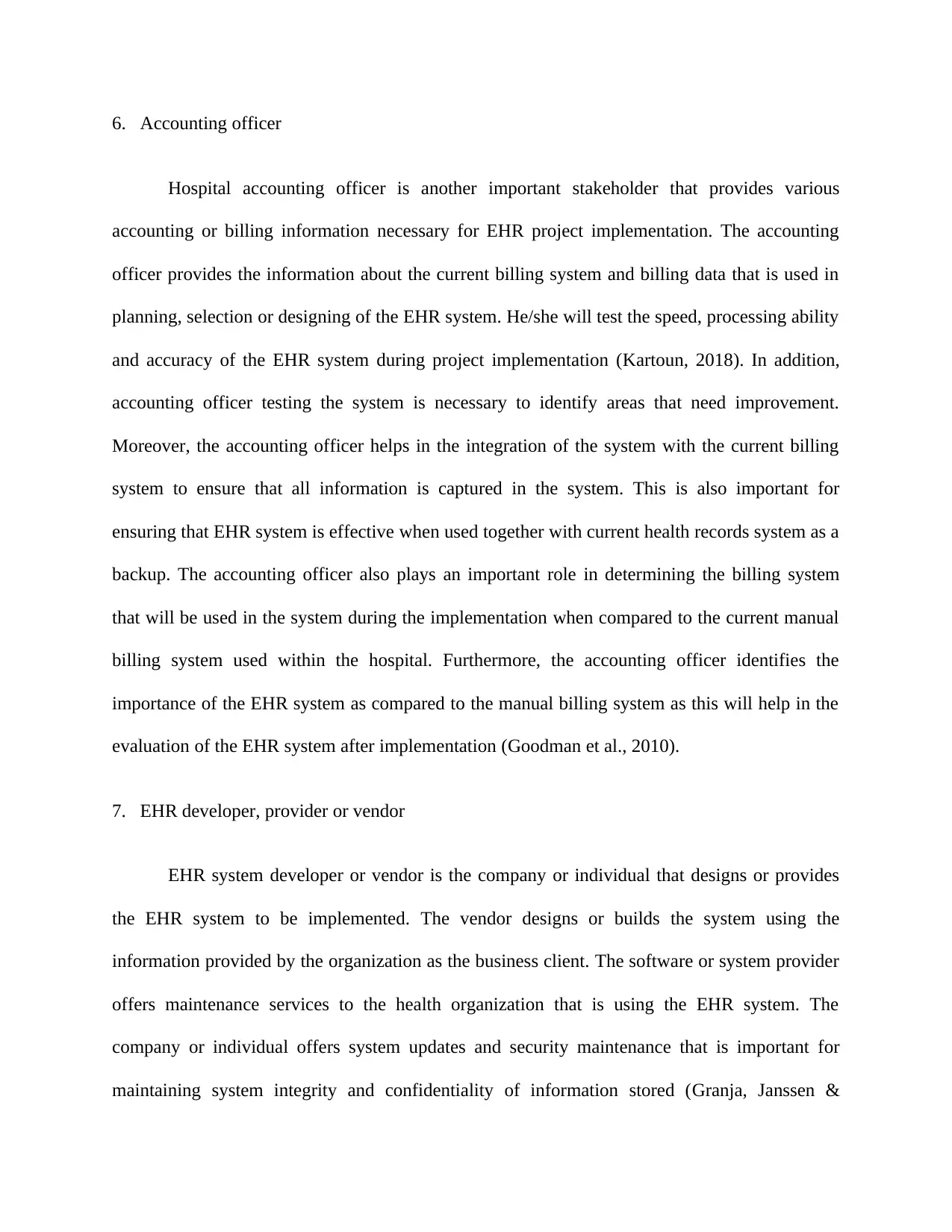
6. Accounting officer
Hospital accounting officer is another important stakeholder that provides various
accounting or billing information necessary for EHR project implementation. The accounting
officer provides the information about the current billing system and billing data that is used in
planning, selection or designing of the EHR system. He/she will test the speed, processing ability
and accuracy of the EHR system during project implementation (Kartoun, 2018). In addition,
accounting officer testing the system is necessary to identify areas that need improvement.
Moreover, the accounting officer helps in the integration of the system with the current billing
system to ensure that all information is captured in the system. This is also important for
ensuring that EHR system is effective when used together with current health records system as a
backup. The accounting officer also plays an important role in determining the billing system
that will be used in the system during the implementation when compared to the current manual
billing system used within the hospital. Furthermore, the accounting officer identifies the
importance of the EHR system as compared to the manual billing system as this will help in the
evaluation of the EHR system after implementation (Goodman et al., 2010).
7. EHR developer, provider or vendor
EHR system developer or vendor is the company or individual that designs or provides
the EHR system to be implemented. The vendor designs or builds the system using the
information provided by the organization as the business client. The software or system provider
offers maintenance services to the health organization that is using the EHR system. The
company or individual offers system updates and security maintenance that is important for
maintaining system integrity and confidentiality of information stored (Granja, Janssen &
Hospital accounting officer is another important stakeholder that provides various
accounting or billing information necessary for EHR project implementation. The accounting
officer provides the information about the current billing system and billing data that is used in
planning, selection or designing of the EHR system. He/she will test the speed, processing ability
and accuracy of the EHR system during project implementation (Kartoun, 2018). In addition,
accounting officer testing the system is necessary to identify areas that need improvement.
Moreover, the accounting officer helps in the integration of the system with the current billing
system to ensure that all information is captured in the system. This is also important for
ensuring that EHR system is effective when used together with current health records system as a
backup. The accounting officer also plays an important role in determining the billing system
that will be used in the system during the implementation when compared to the current manual
billing system used within the hospital. Furthermore, the accounting officer identifies the
importance of the EHR system as compared to the manual billing system as this will help in the
evaluation of the EHR system after implementation (Goodman et al., 2010).
7. EHR developer, provider or vendor
EHR system developer or vendor is the company or individual that designs or provides
the EHR system to be implemented. The vendor designs or builds the system using the
information provided by the organization as the business client. The software or system provider
offers maintenance services to the health organization that is using the EHR system. The
company or individual offers system updates and security maintenance that is important for
maintaining system integrity and confidentiality of information stored (Granja, Janssen &
⊘ This is a preview!⊘
Do you want full access?
Subscribe today to unlock all pages.

Trusted by 1+ million students worldwide
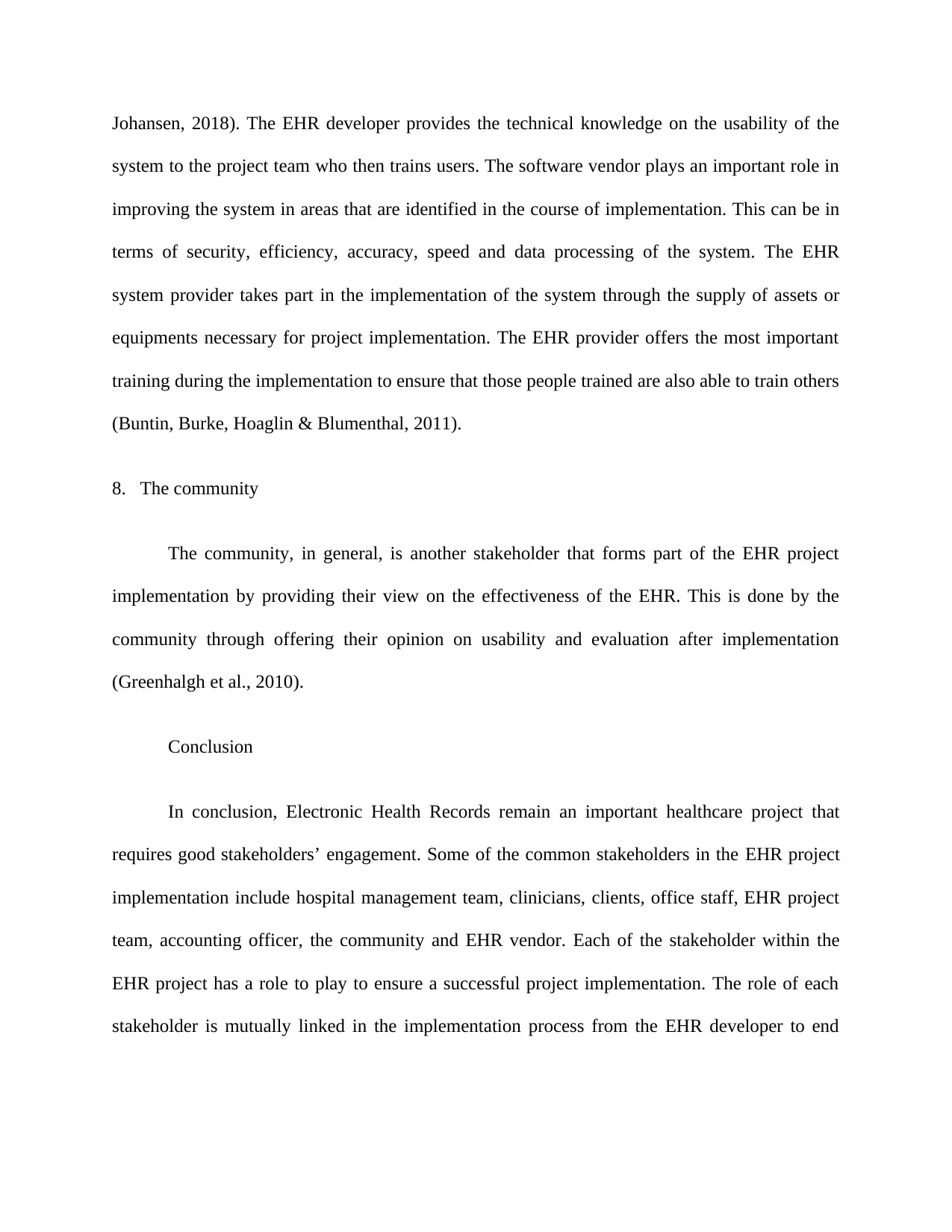
Johansen, 2018). The EHR developer provides the technical knowledge on the usability of the
system to the project team who then trains users. The software vendor plays an important role in
improving the system in areas that are identified in the course of implementation. This can be in
terms of security, efficiency, accuracy, speed and data processing of the system. The EHR
system provider takes part in the implementation of the system through the supply of assets or
equipments necessary for project implementation. The EHR provider offers the most important
training during the implementation to ensure that those people trained are also able to train others
(Buntin, Burke, Hoaglin & Blumenthal, 2011).
8. The community
The community, in general, is another stakeholder that forms part of the EHR project
implementation by providing their view on the effectiveness of the EHR. This is done by the
community through offering their opinion on usability and evaluation after implementation
(Greenhalgh et al., 2010).
Conclusion
In conclusion, Electronic Health Records remain an important healthcare project that
requires good stakeholders’ engagement. Some of the common stakeholders in the EHR project
implementation include hospital management team, clinicians, clients, office staff, EHR project
team, accounting officer, the community and EHR vendor. Each of the stakeholder within the
EHR project has a role to play to ensure a successful project implementation. The role of each
stakeholder is mutually linked in the implementation process from the EHR developer to end
system to the project team who then trains users. The software vendor plays an important role in
improving the system in areas that are identified in the course of implementation. This can be in
terms of security, efficiency, accuracy, speed and data processing of the system. The EHR
system provider takes part in the implementation of the system through the supply of assets or
equipments necessary for project implementation. The EHR provider offers the most important
training during the implementation to ensure that those people trained are also able to train others
(Buntin, Burke, Hoaglin & Blumenthal, 2011).
8. The community
The community, in general, is another stakeholder that forms part of the EHR project
implementation by providing their view on the effectiveness of the EHR. This is done by the
community through offering their opinion on usability and evaluation after implementation
(Greenhalgh et al., 2010).
Conclusion
In conclusion, Electronic Health Records remain an important healthcare project that
requires good stakeholders’ engagement. Some of the common stakeholders in the EHR project
implementation include hospital management team, clinicians, clients, office staff, EHR project
team, accounting officer, the community and EHR vendor. Each of the stakeholder within the
EHR project has a role to play to ensure a successful project implementation. The role of each
stakeholder is mutually linked in the implementation process from the EHR developer to end
Paraphrase This Document
Need a fresh take? Get an instant paraphrase of this document with our AI Paraphraser

user. All in all, the engagement of these stakeholders brings a project framework that ensures
successful HER project implementation.
successful HER project implementation.

Reference
Buntin, M. B., Burke, M. F., Hoaglin, M. C. & Blumenthal, D. (2011). The benefits of health
information technology: a review of the recent literature shows predominantly positive
results. Health Affairs, 30, 464–471
Cebul, R.D., Love, T.E., Jain, A.K., & Hebert, C.J. (September 2011). Electronic health records
and quality of diabetes care. The New England Journal of Medicine, 365 (9): 825–33.
doi:10.1056/NEJMsa1102519
Colligan, L., Potts, H.W., Finn, C.T., & Sinkin, R.A. (July 2015). Cognitive workload changes
for nurses transitioning from a legacy system with paper documentation to a commercial
electronic health record. International Journal of Medical Informatics, 84 (7): 469–76.
Fernández-Alemán, J.L., Sánchez-Henarejos, A., Toval, A., Sánchez-García, A.B., Hernández-
Hernández, I., & Fernandez-Luque, L. (June 2015). Analysis of health professional
security behaviors in a real clinical setting: an empirical study. International Journal of
Medical Informatics, 84 (6): 454–67. doi:10.1016/j.ijmedinf.2015.01.010
Fiks, A.G., Alessandrini, E.A., Forrest, C.B., Khan, S., Localio, A.R., & Gerber, A. (2011).
Electronic medical record use in pediatric primary care. Journal of the American Medical
Informatics Association, 18 (1): 38–44. doi:10.1136/jamia.2010.004135
Granja, C., Janssen, W. & Johansen, M.A. (May 2018). Factors Determining the Success and
Failure of eHealth Interventions: Systematic Review of the Literature. Journal of
Medical Internet Research, 20 (5): e10235. doi:10.2196/10235
Buntin, M. B., Burke, M. F., Hoaglin, M. C. & Blumenthal, D. (2011). The benefits of health
information technology: a review of the recent literature shows predominantly positive
results. Health Affairs, 30, 464–471
Cebul, R.D., Love, T.E., Jain, A.K., & Hebert, C.J. (September 2011). Electronic health records
and quality of diabetes care. The New England Journal of Medicine, 365 (9): 825–33.
doi:10.1056/NEJMsa1102519
Colligan, L., Potts, H.W., Finn, C.T., & Sinkin, R.A. (July 2015). Cognitive workload changes
for nurses transitioning from a legacy system with paper documentation to a commercial
electronic health record. International Journal of Medical Informatics, 84 (7): 469–76.
Fernández-Alemán, J.L., Sánchez-Henarejos, A., Toval, A., Sánchez-García, A.B., Hernández-
Hernández, I., & Fernandez-Luque, L. (June 2015). Analysis of health professional
security behaviors in a real clinical setting: an empirical study. International Journal of
Medical Informatics, 84 (6): 454–67. doi:10.1016/j.ijmedinf.2015.01.010
Fiks, A.G., Alessandrini, E.A., Forrest, C.B., Khan, S., Localio, A.R., & Gerber, A. (2011).
Electronic medical record use in pediatric primary care. Journal of the American Medical
Informatics Association, 18 (1): 38–44. doi:10.1136/jamia.2010.004135
Granja, C., Janssen, W. & Johansen, M.A. (May 2018). Factors Determining the Success and
Failure of eHealth Interventions: Systematic Review of the Literature. Journal of
Medical Internet Research, 20 (5): e10235. doi:10.2196/10235
⊘ This is a preview!⊘
Do you want full access?
Subscribe today to unlock all pages.

Trusted by 1+ million students worldwide
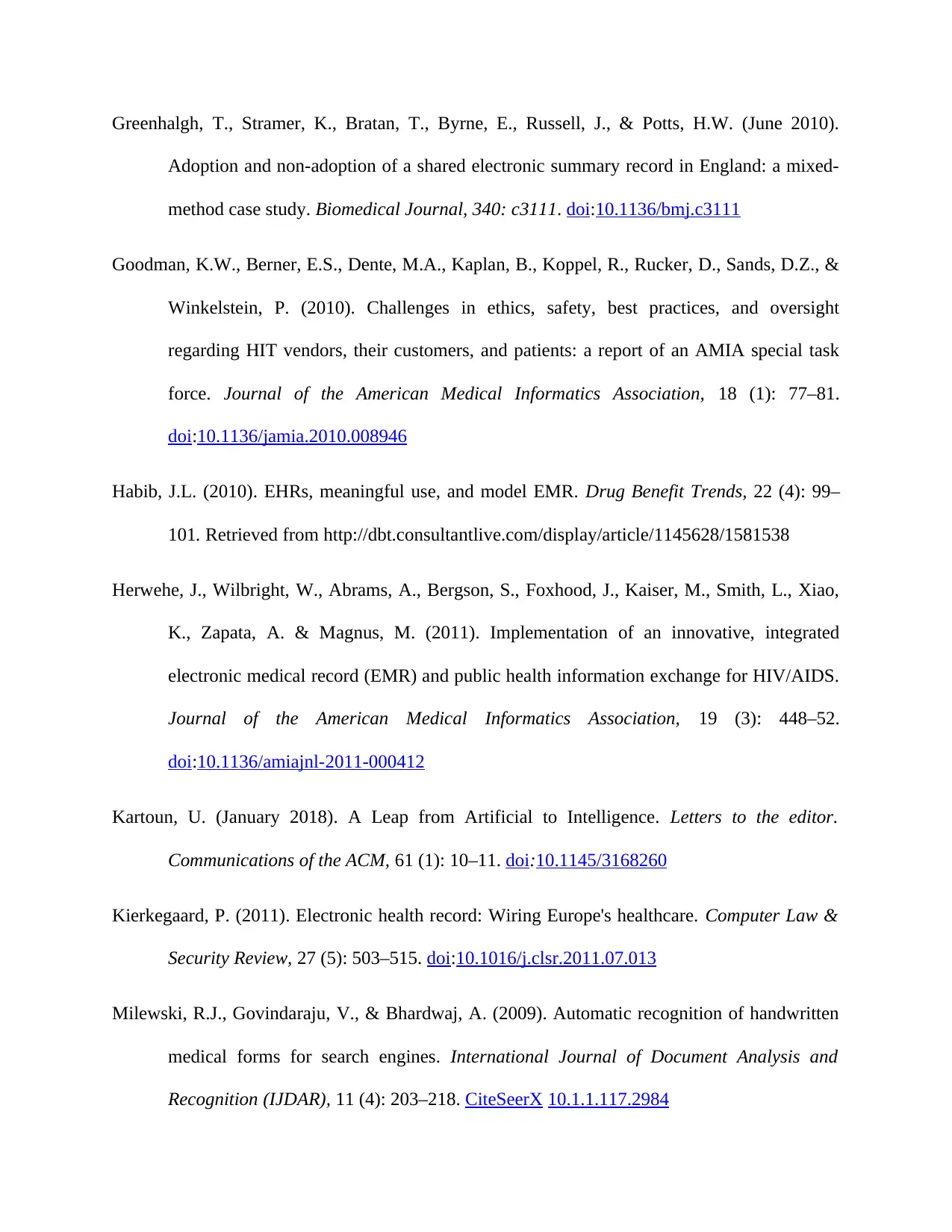
Greenhalgh, T., Stramer, K., Bratan, T., Byrne, E., Russell, J., & Potts, H.W. (June 2010).
Adoption and non-adoption of a shared electronic summary record in England: a mixed-
method case study. Biomedical Journal, 340: c3111. doi:10.1136/bmj.c3111
Goodman, K.W., Berner, E.S., Dente, M.A., Kaplan, B., Koppel, R., Rucker, D., Sands, D.Z., &
Winkelstein, P. (2010). Challenges in ethics, safety, best practices, and oversight
regarding HIT vendors, their customers, and patients: a report of an AMIA special task
force. Journal of the American Medical Informatics Association, 18 (1): 77–81.
doi:10.1136/jamia.2010.008946
Habib, J.L. (2010). EHRs, meaningful use, and model EMR. Drug Benefit Trends, 22 (4): 99–
101. Retrieved from http://dbt.consultantlive.com/display/article/1145628/1581538
Herwehe, J., Wilbright, W., Abrams, A., Bergson, S., Foxhood, J., Kaiser, M., Smith, L., Xiao,
K., Zapata, A. & Magnus, M. (2011). Implementation of an innovative, integrated
electronic medical record (EMR) and public health information exchange for HIV/AIDS.
Journal of the American Medical Informatics Association, 19 (3): 448–52.
doi:10.1136/amiajnl-2011-000412
Kartoun, U. (January 2018). A Leap from Artificial to Intelligence. Letters to the editor.
Communications of the ACM, 61 (1): 10–11. doi:10.1145/3168260
Kierkegaard, P. (2011). Electronic health record: Wiring Europe's healthcare. Computer Law &
Security Review, 27 (5): 503–515. doi:10.1016/j.clsr.2011.07.013
Milewski, R.J., Govindaraju, V., & Bhardwaj, A. (2009). Automatic recognition of handwritten
medical forms for search engines. International Journal of Document Analysis and
Recognition (IJDAR), 11 (4): 203–218. CiteSeerX 10.1.1.117.2984
Adoption and non-adoption of a shared electronic summary record in England: a mixed-
method case study. Biomedical Journal, 340: c3111. doi:10.1136/bmj.c3111
Goodman, K.W., Berner, E.S., Dente, M.A., Kaplan, B., Koppel, R., Rucker, D., Sands, D.Z., &
Winkelstein, P. (2010). Challenges in ethics, safety, best practices, and oversight
regarding HIT vendors, their customers, and patients: a report of an AMIA special task
force. Journal of the American Medical Informatics Association, 18 (1): 77–81.
doi:10.1136/jamia.2010.008946
Habib, J.L. (2010). EHRs, meaningful use, and model EMR. Drug Benefit Trends, 22 (4): 99–
101. Retrieved from http://dbt.consultantlive.com/display/article/1145628/1581538
Herwehe, J., Wilbright, W., Abrams, A., Bergson, S., Foxhood, J., Kaiser, M., Smith, L., Xiao,
K., Zapata, A. & Magnus, M. (2011). Implementation of an innovative, integrated
electronic medical record (EMR) and public health information exchange for HIV/AIDS.
Journal of the American Medical Informatics Association, 19 (3): 448–52.
doi:10.1136/amiajnl-2011-000412
Kartoun, U. (January 2018). A Leap from Artificial to Intelligence. Letters to the editor.
Communications of the ACM, 61 (1): 10–11. doi:10.1145/3168260
Kierkegaard, P. (2011). Electronic health record: Wiring Europe's healthcare. Computer Law &
Security Review, 27 (5): 503–515. doi:10.1016/j.clsr.2011.07.013
Milewski, R.J., Govindaraju, V., & Bhardwaj, A. (2009). Automatic recognition of handwritten
medical forms for search engines. International Journal of Document Analysis and
Recognition (IJDAR), 11 (4): 203–218. CiteSeerX 10.1.1.117.2984
Paraphrase This Document
Need a fresh take? Get an instant paraphrase of this document with our AI Paraphraser

Porter, A., Potts, H., Mason, S., Morgan, H., Morrison, Z., Rees, N., Shaw, D., Siriwardena, N.,
Snooks, H., & Williams, V. (2018). The digital ambulance: Electronic patient clinical
records in prehospital emergency care. Biomedical Journal Open, 8 (Suppl 1): A26-7
Peter, B., Lars, J.J. Jensen, & Søren, B. (2012). Mining electronic health records: towards better
research applications and clinical care. Nature Reviews Genetics 13, pages 395–405.
Yao, L., Zhang, Y., Li, Y., Sanseau, P. & Agarwal, P. (2011). Electronic health records:
implications for drug discovery. Drug Discovery Today, 16, 594–599.
Snooks, H., & Williams, V. (2018). The digital ambulance: Electronic patient clinical
records in prehospital emergency care. Biomedical Journal Open, 8 (Suppl 1): A26-7
Peter, B., Lars, J.J. Jensen, & Søren, B. (2012). Mining electronic health records: towards better
research applications and clinical care. Nature Reviews Genetics 13, pages 395–405.
Yao, L., Zhang, Y., Li, Y., Sanseau, P. & Agarwal, P. (2011). Electronic health records:
implications for drug discovery. Drug Discovery Today, 16, 594–599.
1 out of 11
Related Documents
Your All-in-One AI-Powered Toolkit for Academic Success.
+13062052269
info@desklib.com
Available 24*7 on WhatsApp / Email
![[object Object]](/_next/static/media/star-bottom.7253800d.svg)
Unlock your academic potential
Copyright © 2020–2025 A2Z Services. All Rights Reserved. Developed and managed by ZUCOL.





